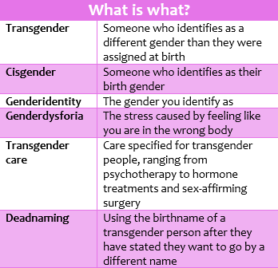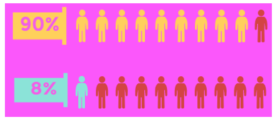Puberty
Improved mental health in transgender adolescents through puberty blockers
By Marieke Blom, April 8 2022
During puberty you develop from a boy or girl to a man or woman. This development is complicated for almost every adolescent, but especially for those who are transgender or have doubts about their gender identity. For them, their bodies develop “wrong” and it is difficult to get help with this. On February 6, 2022 was the most recent demonstration in Amsterdam against the long waiting lists in transgender care. Because the taboo around gender identity is decreasing, there are more and more people who apply for transgender care. This in combination with the limited places where this care is offered causes long waiting lists. For transgender children, this is a time during which their bodies continue to develop into a different gender than they identify with. This can have negative effects on their mental health and lead to depression, anxiety disorders and suicidal thoughts. This suffering can be largely prevented by the use of puberty blockers.

Waiting times for transgender care are currently more than two years in the Netherlands. This concerns the waiting time from registering for care to the intake appointment, after which it can take another two months or more before the actual treatment starts. In part this is due to the limited availability for these treatments as they are only offered in Amsterdam, Nijmegen and Groningen, but also because there are many transgender people. According to a study by knowledge institute Movisie in 2019, 3.9% of the Dutch population identifies as transgender. This means that over 660.000 people are transgender, of which around 37.600 are between the ages of 10 and 15. This is many more people than was previously thought.
Many people, few places, so long waiting lists. Having to wait a long time for treatment often has far-reaching consequences. Transvisie interviewed 1237 transgender adolescents who indicated that having to wait for a long time caused struggles ranging from frustration and stress to depression and suicidal thoughts. A quote from one of their interviews is “I’m afraid I won’t make it to 20 if I have to do so in this body”. But these struggles are not only caused by the long waiting times. According to Diana Tordoff, researcher at the University of Washington, this is also due to transgender people often not being supported by their surroundings, lacking support from parents and because they are often bullied.
Michael, who is transgender himself, explains how this social aspect affected his mental health: “Puberty was pretty grim for me. Boys were developing into a body that I wanted to have too, while I was stuck in a body and social expectations that I didn’t want at all. I could cut my hair short and wear oversized shirts, but I was constantly reminded that that it would never be enough, and that makes you quite dysphoric. Getting breasts was hard, but in the end I think the social aspect was harder.”.
Gender dysphoria, the stress of developing in the wrong body, ca be countered in part by puberty blockers. But even for puberty blockers, the waiting times are very long. “I knew I was transgender at 14, so I was already too old for puberty blockers. For those you have to be on a waiting list when you are 10.” Says Michael, “That would have been difficult for me anyway, because I would have needed my parents’ support to start treatment, and they found it hard to accept me as transgender for a long time.”.
So we know that transgender individuals are more likely to suffer from depression and suicidal thoughts, but exactly how much more likely? This is what Diana Tordoff’s 2022 study was all about, with shocking results. Of all transgender people, 90% have ever had suicidal thoughts and 51% have ever attempted suicide. These are high percentages, which are even more shocking when compared to data from the Trimbos institute. They show that 8% of the Dutch population has ever had suicidal thoughts and 2% has ever attempted suicide. This means that transgender people are 10 times more likely to have suicidal thoughts and 25 times more likely to attempt suicide! In combination with the fact that suicide is the number one cause of death among Dutch youth, this indicates how important it is that transgender children get the help they need.

90% of transgender people have had suicidal thoughts at some point, as opposed to 8% of the total Dutch population
Diana’s research also offers hope: when transgender children were able to use puberty blockers, the risk of depression decreased by 60% and the risk of suicidal thoughts by 73%. Puberty blockers are thus an essential component in the treatment of transgender youth. Michael would have liked to use puberty blockers “Then I could have had more of my childhood ‘as a boy’, I do think that is important.”.
In the Netherlands, you can start taking puberty blockers at 11 years old. Puberty blockers are, as the name implies, substances that prevent you from starting puberty. They are substances that block the release of sex hormones (testosterone or oestrogen), preventing your body from developing into a man or woman. By delaying puberty, there is more time to discover your gender identity without increasing gender dysphoria. The effect of puberty blockers is completely reversible. When you are in treatment at a gender clinic, around the age of 16 you will need to make a choice about how you want to develop further. At that point you can choose to stop taking them and develop to your birth gender. You can also choose to continue hormone treatment and develop into the opposite sex.
In 2021 Lynn Rew summarized all studies that have been done on the effects of puberty blockers. There are a growing number of studies that indicate puberty blockers are beneficial to the mental health of transgender youth. Particularly important is the reduction of suicidal thoughts. But puberty blockers also have side effects, for example they make you grow slower. Yet most studies agree that the (possible) side effects do not outweigh the proven positive effects of puberty blockers. “by reducing suicidal thoughts, puberty blockers can be life-savers, this far outweighs any possible effects on how tall a person grows.” Says Lynn.
Parents have an important role in helping their child access puberty blockers, but also in creating a safe home environment. A home environment where a child is given the space to explore his, her or their gender identity is essential for their mental health. This may sound obvious, but unfortunately it is not always the case. According to figures from the Sociaal Cultureel Planbureau, compared to cisgender youth, transgender youth are more likely to experience emotional neglect and abuse. Emotional neglect, such as parents that do not listen to their child and ignore their experiences, is experienced by 30% of transgender children compared to 13% of cisgender children. The same holds for abuse; being threatened, kicked or beaten occurs in 15% of transgender children and 7% of cisgender children.
Michael has a few tips for parents: “I personally find that I get the most support when my father explicitly says every now and then that he is doing his best not to deadname me, even if he does not always succeed. Also, just don’t try to hide it away of clearly avoid talking about it, because that makes it feel like it is something to be ashamed of. Just talk about is! No matter how difficult that can be sometimes.”.
Sources
- Diana M Tordoff et all. (2022) Mental health outcomes in transgender and nonbinary youths receiving gender-affirming care.
https://pubmed.ncbi.nlm.nih.gov/35212746/ - Lynn Rew et all. (2021) Review: Puberty blockers for transgender and gender diverse youth-a critical review of the literature.
https://pubmed.ncbi.nlm.nih.gov/33320999/ - Jack L Turban et all. (2020) Pubertal suppression for transgender youth and risk of suicidal ideation.
https://www.ncbi.nlm.nih.gov/pmc/articles/PMC7073269/ - https://www.radboudumc.nl/expertisecentra/geslacht-en-gender/transgenderzorg/transgenderzorg-voor-kinderen-jongeren/wachttijd/wachtlijst
- https://www.vumc.nl/web/file?uuid=c04a8b57-c3f7-4f35-a71c-f1966c56293d&owner=5ec2d559-9d3f-4285-8cbd-140abc921b69&contentid=3013&disposition=inline
- https://www.umcg.nl/w/wachttijden-genderteam
- https://www.movisie.nl/sites/movisie.nl/files/2019-03/Handreiking%20LHBTI-Feiten%20en%20Cijfers%202018_0.pdf
- https://www.transvisie.nl/wp-content/uploads/2019/11/onderzoeksrapport-ervaringen-en-behoeften-van-transgenders-in-de-zorg-v.1-1-1.pdf
- https://www.scp.nl/publicaties/monitors/2018/11/21/lhbt-monitor-2018
- https://www.trimbos.nl/docs/0cf4050d-e0d3-453f-b6b4-3aa245f5c5d8.pdf
- https://www.nji.nl/cijfers/overlijden-kind#:~:text=In%20de%20leeftijdsgroep%2015%2D20,2019%20naar%201.063%20in%202020

